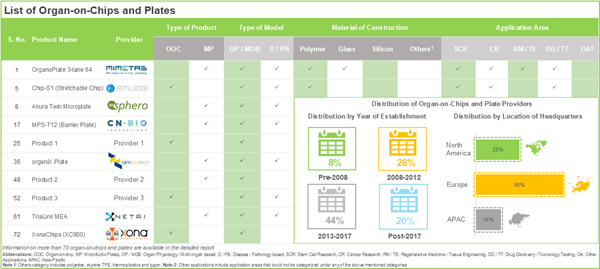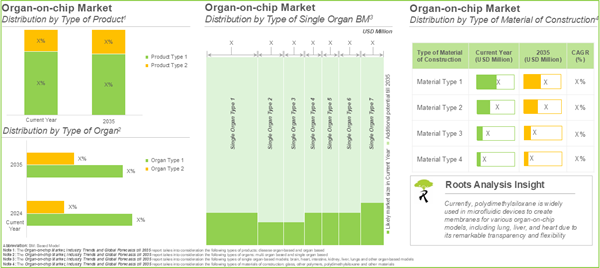Dublin, March 25, 2025 (GLOBE NEWSWIRE) — The “Organs-on-Chips Market Industry Trends and Global Forecasts to 2035, by Type of Product, Type of Organ, Type of Single Organ based Model, Type of Material of Construction, Purpose, Application Area, End User, Key Geographical Regions and Leading Players” report has been added to ResearchAndMarkets.com’s offering.
The global organ on a chip market size is estimated to grow from USD 77 million in the current year to USD 944 million by 2035, at a CAGR of 25.6% during the forecast period, till 2035.
According to research, 1 out of 1,000 drug candidates proceed to clinical trials post preclinical testing. Of these, 90% of the candidates fail to enter the market, primarily due to the lack of efficacy / unforeseen toxicity observed during the clinical trials and the limitation of animal based preclinical models to precisely predict human responses (owing to the difficulty in mimicking the exact and intricate human biology / mechanisms).
Therefore, to address these issues / limitations and in an effort to reduce the healthcare burden due to drug failures, several researchers are striving to adopt alternative testing methods, such as organ-on-a-chip technology. Currently, 75 integrated organ-on-chip technologies and models are available in the market, offering distinct advantages over the traditional cell culture and animal-based testing methods, such as enhanced accuracy in predicting physiological responses like humans, high in vivo replicability, reduced trial costs and dependency on animal models.
Driven by these benefits and the interest of industry stakeholders, the adoption of these advanced models in the R&D of novel drugs and ADME toxicology testing is steadily increasing and is anticipated to improve the success rates of drugs in clinical trials. Moreover, as the global organ-on-chip market matures, the development and application of these models will expand, driving innovation and positioning the market for steady growth in the forthcoming years.
Organs-on-Chips Market: Key Segments
Disease-based Model is the Fastest Growing Segment of the Organs-on-Chips Market
Based on the type of product, the global market for organs-on-chips is segmented into organ based and disease-based models. Currently, majority share of the organ-on-chip market is captured by organ-based models. It is worth mentioning that the disease-based model segment is likely to grow at a higher CAGR (around 27%) in the coming years.

Organ-on-Chip Products Supporting Single Organ-based Models are Likely to Dominate the Organs-on-Chips Market During the Forecast Period
Based on the type of organ, the global organs-on-chips market is distributed across single organ and multi organ-based models. Whilst the organs-on-chip products supporting single organ-based models hold the majority of the market share, it is worth noting that organ-on-chip market for multi-organ-based models is likely to grow at a relatively higher CAGR during the forecast period. This can be attributed to the capability of multi-organ models to efficiently track metabolic pathways and assess organ-organ crosstalk.
Liver-on-a-Chip Models are Likely to Hold the Largest Share of the Organs-on-Chips Market During the Forecast Period
Based on the type of single organ-based model, the global market is segmented into liver, lung, brain, heart, intestine, kidney and other organs-based models. Currently, the liver-on-a-chip models are likely to dominate and drive the overall market growth. It is worth noting that the lung, brain, and heart-on-a-chip models are likely to flourish during the forecast period. This can be attributed to the ability of these models to mimic the exact and intricate human biology / mechanisms.
Organs-on-Chips Market for Other Polymers is Likely to Grow at a Relatively Faster Pace During the Forecast Period
Based on the type of material, the global market value is segmented across polydimethylsiloxane (PDMS), other polymers, glass and other materials. Notably, owing to the high flexibility, transparency and gas permeability of PDMS, it is likely to dominate the organs-on-chips market during the forecast period.
Organs-On-Chips Market for Therapeutic Purposes is Likely to Grow at a Higher CAGR During the Forecast Period
Based on purpose, the global market is segmented into research and therapeutic purposes. Currently, organ-on-chips focussed on research purposes hold a larger share of the overall market. However, this trend is likely to change during the forecast period due to the expanding application of such chips across multiple therapeutic areas.

By Application Area, Organs-on-Chips for Cancer Research are Likely to Dominate the Market During the Forecast Period
Based on the application area, the global market for organs on chips is distributed across drug discovery and toxicity testing, cancer research, stem cell research and tissue engineering and regenerative medicines. Whilst the organs-on-chip models and plates for cancer research will be the primary drivers of the overall market, it is worth highlighting that the market for organ-on-chips models used in stem cell research and tissue engineering is likely to grow at a relatively higher CAGR.
Currently, Pharmaceutical and Biotech Companies Hold the Largest Share of the Organs-On-Chips Market
Based on end users, the global market is segmented into pharmaceutical and biotech companies, academic and research players, cosmetic industry players, and other end users. Currently, pharmaceutical and biotech companies hold the largest market share. However, organ-on-chip market for cosmetic industry is expected to witness substantial growth in the coming years.
North America Accounts for the Largest Share of the Market
In the current scenario, North America is likely to capture the largest market share. However, owing to the ban on animal model testing in European countries, the organ-on-chip market in Europe is expected to grow at a higher CAGR during the forecast period.
Organs-on-Chips Market: Key Insights
- More than 70 organ-on-chip technologies and models have been launched / approved or are currently under development; the market landscape features the presence of both established players and new entrants.
- Majority of the technologies and models support both organ-based and disease-based applications; of these, 98% of the technologies / models are preferred for drug discovery and toxicity testing studies.
- Presently, 25 players (established players as well as start-ups) claim to provide organ-on-chips and plates; more than 60% of these firms have been established post-2013.
- Over 50% of organ-on-chips products are microfluidic plates; interestingly, majority of these chips and plates are constructed from polymers due to their flexibility and moldability.
- More than 600 patents related to organ-on-chip have been filed / granted by industry and non-industry stakeholders, indicating a growing intellectual capital in the domain.
- The growing interest of stakeholders is evident from the increasing partnership activities; technology / product utilization agreements emerged as the most prevalent partnership model adopted by organ-on-chip providers.
- Close to 350 grants have been awarded for ongoing research and development efforts for organ-on-chip products and technologies; National Center for Advancing Translational Sciences has awarded the maximum grant amount.
- Since 2017, over USD 350 million have been invested by several investors across various funding rounds, thereby presenting lucrative growth opportunities within this emerging segment.
- In recent years, stakeholders have established strong brand positions to cater to the increasing demand for organ-on-chips; several players have introduced efficient, easy to use, and advanced products.
- The growing demand for animal free testing and advancements in microfluidics has emerged as key driving factors supporting the rapid evolution of the organ-on-chip market.
- Owing to the ability of organ-on-chips to provide animal free testing models and substantially reduce the costs associated with drug testing, the market is anticipated to witness a growth of 25.6% over the next decade.
Players in the Organs-on-Chips Market Profiled in the Report:
- 4DCell
- Aim biotech
- Beonchip
- Bi/ond
- CN BIO
- Emulate
- InSphero
- Jiksak Bioengineering
- Kirkstall
- Lena Biosciences
- Merck Millipore
- MesoBio Tech
- MicroBrain Biotech
- Mimetas
- Numa Biosciences
- Qureator
- SynVivo
- TissUse
- Visikol
- Xona microfluidics
Primary Research Overview
The opinions and insights presented in this study were influenced by discussions conducted with multiple stakeholders. The research report features detailed transcripts of interviews held with the following industry stakeholders:
- Chief Executive Officer, Small Company, US
- Chief Executive Officer, Mid-sized Company, France
- Chief Executive Officer, Small Company, South Korea
- Chief Executive Officer, Small Company, Italy
- Chief Executive Officer, Small Company, Scotland
- Chief Technology Officer, Mid-sized Company, The Netherlands
- Chief Business Development Officer, Mid-sized Company, France
- President, Mid-sized Company, US
Additional Benefits
- Complimentary PPT Insights Packs
- Complimentary Excel Data Packs for all Analytical Modules in the Report
- 10% Free Content Customization
- Detailed Report Walkthrough Session with Research Team
- Free Updated report if the report is 6-12 months old or older
For more information about this report visit https://www.researchandmarkets.com/r/fzjkfd
About ResearchAndMarkets.com
ResearchAndMarkets.com is the world’s leading source for international market research reports and market data. We provide you with the latest data on international and regional markets, key industries, the top companies, new products and the latest trends.

